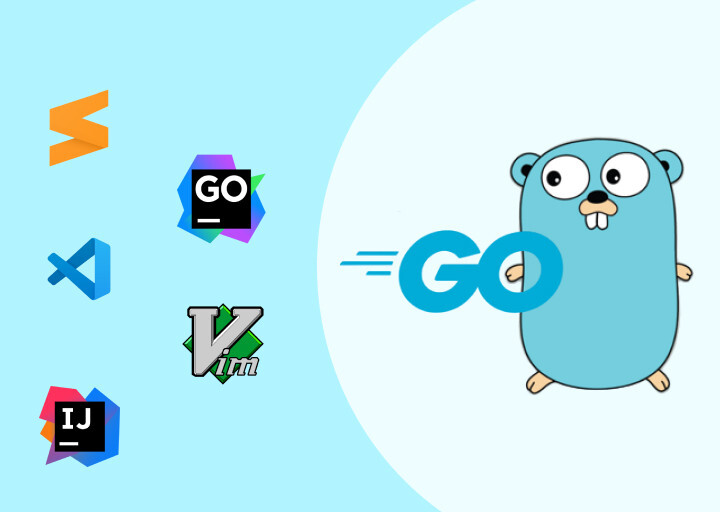Google’s Go Programming Language or Golang was introduced in 2007, and it has gained immense popularity among users due to its effectiveness, simplicity, and competitiveness. The language is designed for building low-level monoliths for Google and is ideally suited to service-oriented architectures because of its easy deployment, scalability, and productivity. This article provides a list of the best Golang IDEs and tools that developers can use to streamline their code and navigate it easily.
Table of Contents:
1. Top Golang IDEs
2. Best Golang Development Tools for Fast and Easy App Development
3. Conclusion

Top Golang IDEs
1- Visual Studio Code
This full-featured, open-source code editor and IDE by Microsoft is popular among developers for its robust completion with IntelliSense, Git integration, debugging, hierarchical file explorer, and an interactive console.
2- LiteIDE
This simple and cross-platform open-source Go IDE offers many useful features, such as a code editor, build commands, MIME-type management, expandable Golang support, file search, and fast open files and symbols.
3- Goland
This commercial yet sophisticated IDE from Jetbrains provides smart code completion, fast navigation, tabbed interface, refactoring, and other coding support features.
4- Wide
This web-based IDE is perfect for collaborative development in web development teams and companies. Its extensive features include debugging, Git integration, and code highlighting.
5- Vim
This open-source IDE can be configured and tailored with different plugins and features source code assessment, Go-to definition, multiple third-liner assistance, and more.
6- Eclipse with GoClipse
GoClipse is a plugin for Eclipse that provides Go source code editing with automatic indentation, syntax highlighting, and brace completion. It also includes code support and debugging functionality.
7- Komodo
This full-featured IDE supports other programming languages like Python, Node.js, Perl, Ruby, and so forth. Its features include intelligent code completion, unit testing, syntax checking, version control, and Golang Code Intelligence.
8- Sublime Text with GoSublime
GoSublime is a plugin for Sublime Text 3 that provides code completion from Go Code, syntax check, and automatic addition and removal of package imports.
9- IntelliJ IDEA
This popular and strong integrated development environment requires a Golang support plugin for Go language. It uses a rapid indexing method that offers import suggestions and contextual hints on auto-completion object members.
10- Atom with Go-plus Plugin
This open-source package enhances the code editing experience in Golang by providing real-time feedback on code quality, testing, and debugging.
Best Golang Development Tools for Fast and Easy App Development
Golang development tools are essential for developers who are building web apps and projects. These tools help developers write code and develop apps quickly and easily. In this article, we will discuss the best Golang development tools that can help developers enhance their productivity and streamline their workflows.
1- Go Vendor
Go Vendor is a Golang tool that works seamlessly with the standard Vendor folder. It allows developers to copy their current dependencies from $GOPATH and add or update them with ease. Developers can also use Go Vendor fetch to pull new dependencies or update existing ones. Additionally, Go Vendor migrate can help developers transit legacy systems.
2- Gonative
Gonative is a Golang tool that enables developers to create Go Toolchains using native libraries that can be easily cross-compiled. Gonative downloads binary distribution for every platform to keep these libraries updated.
3- Depth
Depth is a Golang tool that helps website developers visualize and retrieve Go source code dependency trees. Developers can use Depth as a specific package within their project or as a standalone command-line app. Customizations can be added by putting relevant flags on the Tree before fixing it.
4- Checkstyle
Checkstyle is used in Golang to print out coding style recommendations. Developers can inspect file line or function, param, or line number, which can be easily configured.
5- Apicompat
Apicompat is a new Golang tool that helps developers recognize backward, exported declarations, and incompatible changes. With this tool, developers can abstain from fake positives. However, not all backward or incompatible changes can be recognized by Apicompat, so developers should still consider swapping argument parameters and other transformations.
6- Go-Swagger
Go-Swagger is a Golang toolkit that incorporates many functions and features. It is an application of Swagger 2.0 that can serialize and de-serialize the specifications of Swagger. Go-Swagger helps in validating against JSONSchema, creating APIs depending on Swagger specifications, and creating specification documents depending on the code.
7- Go-Callvis
Go-callvis is a Golang tool that enables developers to visualize the Go program’s call graph using Graphviz’s dot format. This tool is particularly helpful for developing large projects using complicated codebases or understanding other developers’ code structures.
8- Go Meta Linter
Go Meta Linter is a Golang tool designed to run Go lint tools and normalize their output simultaneously. It is intended to be used with IDE integration or a text editor such as Atom Go-plus package, Sublime Linter plugin, Neovim/Vim, Emacs Flycheck checker, or Visual Studio Code. It supports several configuration files and linters like JSON.
9- Gosimple
Gosimple is a Golang linter that concentrates on easing Go source code. It always targets the most recent Go version and recommends the simplest and easiest technique for avoiding complex structures.
Conclusion
Golang has a powerful ecosystem that comprises different choices for the development environment. We have discussed the top 10 Golang development tools that can help developers enhance their productivity and streamline their workflows. However, there are more tools available, and developers should choose the right ones based on their specific needs. The right choice of tools can make Golang development worthier and even more appropriate.